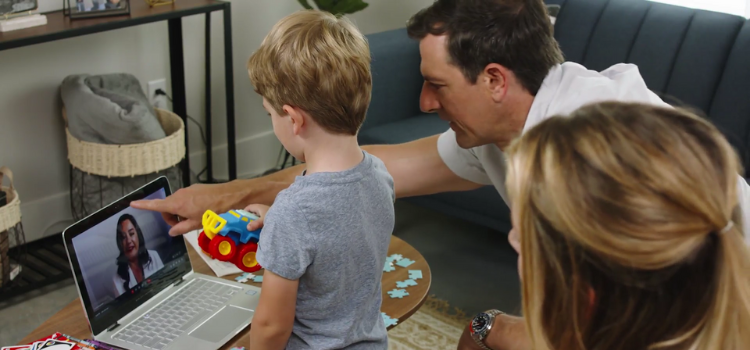Autism care is most effective earlier in life when a child’s neuroplasticity is at its prime. However, provider shortages and other challenges have led to long waitlists and significant delays for families seeking diagnosis, ultimately delaying any early intervention. SmartBrief recently spoke with Dr. Steve Hicks, Chief Medical Officer of As You Are, about how a virtual diagnosis can help get resources and care to families sooner.

Why is there a delay in autism diagnosis, and how does it affect patients?
The delay arises from a lot of different factors, but one is that the rates of autism have continued to rise over the last two decades from 1 in 150 to 1 in 36. Many families need answers in order to seek appropriate interventions; and right now, we don’t have enough physicians trained to diagnose autism, which leads to really long waitlists. Part of the issue is that the paradigm we’ve been using to evaluate children is very comprehensive. It historically has involved a multidisciplinary team with several specialists, and could take up to several hours. A time requirement of this stature means fewer children can be seen on any given day, delaying access to early intervention and therapy services which are shown to have a greater impact on a child’s developmental trajectory.
Meanwhile, there are disparities in autism diagnosis due to multiple socioeconomic, racial, ethnic, gender and geographic factors. A recent study highlights how access to services such as where families reside and whether a family has health insurance or financial resources can impact the probability and speed of an autism diagnosis.
Can autism be diagnosed virtually?
One of the bright spots of the pandemic was that it forced healthcare providers to come up with new ways to provide care. The International Collaborative for Diagnostic Evaluation of Autism (IDEA) Consortium, a grassroots organization developed during the COVID-19 pandemic, quickly grew to include service providers from 91 centers across seven countries to create solutions for autism diagnostics, when in-person assessments were no longer an option.
Since that time, there has been mounting literature support suggesting virtual evaluations can reliably identify autism, particularly in individuals with high levels of symptoms. In a 2019 study, telehealth autism diagnostic appointments in rural areas led to a 15% increase in family attendance. Additionally, a follow up study, determined that clinicians conducting virtual evaluations could accurately identify autism in a high portion of referral cases, and perhaps more importantly, no children were inaccurately identified as having autism.
Does the process or criteria differ for virtual vs. in-person diagnosis?
Consistent with current standards, the As You Are virtual evaluation process uses the same criteria as in-person evaluations, based on the DSM-5 Manual developed by the American Psychiatric Association, combined with questionnaires and play-based assessment tools that are designed to be administered in telehealth appointments.
Board-certified pediatricians receive extensive training to implement these evidence-based assessment processes which include a clinical interview, a standardized behavioral observation using the CARS-2(obs) or TELE-ASD-PEDS (TAP) (depending on the child’s age), and a results visit. The main difference between an in-person appointment and virtual one is that physicians coach parents through activities for their child to complete while the physician observes. This process facilitates more parent involvement in the evaluation process and reduces stress and burden associated with going to a doctor’s office. It also allows the child to be evaluated in a more natural environment, the comfort of their own home.
To maintain reliability, at As You Are, 5%-10% of cases are reviewed by a child psychologist or developmental pediatrician. In the event of a more complex case, for instance when a child has multiple medical conditions, our team may recommend an in-person assessment by a local clinician.
With virtual evaluations, we are removing the barriers faced by families across the country. We also see children with a variety of insurance, including Medicaid, in an effort to reduce socioeconomic barriers.
What happens after the diagnosis in terms of support and resources?
Whether a child receives an autism diagnosis or not, our physicians will make recommendations and guide families to local services and resources. Families can also be connected with a care sidekick who will work together with families to plan the next steps by identifying local resources and supports.* There is no limit to the number of visits families can schedule with their care sidekick. *Care coordination services vary by state and each child’s health insurance plan.
Dr. Steve Hicks is the Chief Medical Officer of As You Are, and an Associate Professor of Academic General Pediatrics at the Pennsylvania State College of Medicine in Hershey, PA. In addition to his work at As You Are and Penn State, he is a physician scientist who has served the Central Pennsylvania community as a general pediatrician since 2015, performing well-child check-ups, sick visits and developmental evaluations. His clinical focus is on the early and accurate diagnosis of autism. Dr. Hicks’ interest in autism stems from his Ph.D. training in neurogenetics. As a physician scientist, he studies the influence of genetics and the environment on pediatric diseases involving growth and neurodevelopment.
